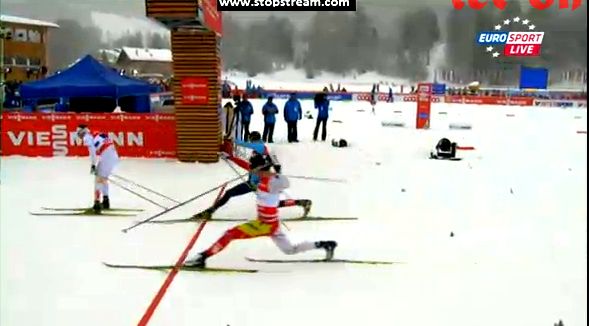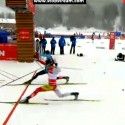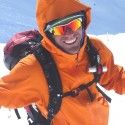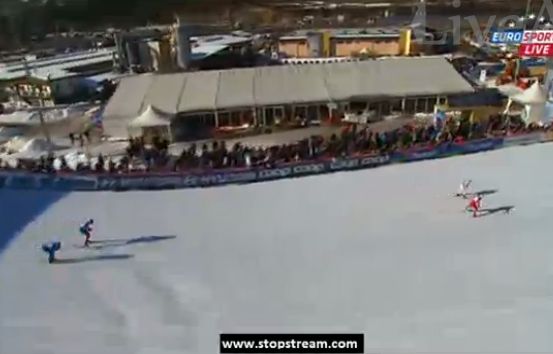![Out on my own for a bit between groups in the always fast and furious pursuit race on Sunday in Kuusamo. Got to stay positive - better races on the horizon - this was a good indicator of that! [P] Nordic Focus](http://skitrax.com/wp-content/uploads/2012/12/KershKuus3.jpeg) December 06, 2012 (St. Ferreol les Neiges, QC) – It’s December. I almost had to tell myself out loud of that fact this morning when I rollerskied through the ice and grime that covered the streets of St. Ferreol les Neiges hugging the tarmac like the hair on my upper lip this past November. I guess I also had to remind myself of the month – because it’s a rarity these days that I’m back in Canada during the winter months.
December 06, 2012 (St. Ferreol les Neiges, QC) – It’s December. I almost had to tell myself out loud of that fact this morning when I rollerskied through the ice and grime that covered the streets of St. Ferreol les Neiges hugging the tarmac like the hair on my upper lip this past November. I guess I also had to remind myself of the month – because it’s a rarity these days that I’m back in Canada during the winter months.
November is always a busy month – lots of racing, lots of travel all coupled with very little sunlight and culinary disaster. I’ve already raced three weeks this season, two of which were the first two World Cup stops of the 2012/13 year. I’ll take a moment to fill you in on the happenings of Northern Scandinavia – with some brief race reports from the opening weekends of racing this November.
![Lenny Valjas and his mo'. Snap. [P] Nordic Focus](http://skitrax.com/wp-content/uploads/2012/12/beststash.jpeg)
Also – big thanks to all that donated to “Movember” and “the Snow Mos” this year – together we can make a difference in men’s health. In that spirit get a load of these two beauty shots of Lenny – bringing his Mo to the next level.
Ostersund/Bruksvallarna, SWE
It may sound like I’ve written this report before – and that’s probably because I have last year. The past few years our team begins our winter campaign smack in the middle of Sweden. In a slight plot twist, I traveled to Oslo November 2nd for a fabulous week in the Norwegian capital before meeting the team in the Jämtland capital of Ostersund for our annual pre-season on snow Euro camp.
Like last year, there was no natural snow, and my first ski in Sweden was an uninspiring burn around a 2.5min loop. The dizziness subsided every couple days as the loop gradually improved thanks to a wonderful group of passionate volunteers and staff of the Ostersund Ski Club – as they spread out the saved snow from last winter (like what Canmore does now with their “Frozen Thunder” project) to prepare the trails for the World Cup of biathlon season openers that take place there. By the time we left Ostersund they had 4km of great skiing available.
![Did I say it was cold up in Kuus' yet? Skating away to another disappointing skate race. 35th in this one... [P] Nordic Focus](http://skitrax.com/wp-content/uploads/2012/12/KershKuus10.jpeg)
On the training side of things, November is a busy month – not only with racing but also with hours. To be ready and keep consistent in the meat of the season (January, February, March) we’ve realized that I need to log a decent amount of miles – short loops or not – so I trained quite hard both in Ostersund, and afterwards.
The “actual” racing season started over in Bruksvallarna (the site of the Swedish FIS openers – a 3hr drive West of Ostersund) and conditions there were fairly decent with thin natural snow cover, longer skiing options (for training), and great snow cover on the race courses – which are twisty with no real huge climbs or working sections. Think – ghetto amusement park rollercoaster.
After some discussion, Justin and I decided to compete only in the 15km skate (what I did last year) and like last year I was brutal finishing a disappointing 10th – blowing up fiercely in the last 3km of the course, where I gave up a whopping 50 seconds. Racing is hard – super hard – but at this time of year, it appears I struggle to digest the heavy load of training I’m under, leaving me feeling flat for some weeks. I guess it was a better outing than last November – when I finished outside the top 30 – but I was both exhausted physically at the end (the last tuck down the last hill made a bit of a buzz on Swedish blogs for my unorthodox tucking technique (think: hands on knees with straight legs trying as hard as I can to not just fall over) and obviously disappointed with the result.
Gallivare, SWE – World Cup Opener
While Ostersund can be grey and windy – the town itself is great and the giant/beautiful lake (5th largest in Sweden apparently) is stunning. It’s actually a beautiful little city all around with great little cafés, nice walking streets – a cool place to hang out. Gallivare by contrast is…well… different. For starters it’s dark. I mean, hella’ dark this time of year – the sky brightens for some hours between the hours of 10:30 – 13:30, but aside from that it’s like what I’d imagine living in a freezer would feel like. Sometimes there’s some light (when someone opens the freezer drawer), but for the most part in the late autumn it’s black and cold. The town itself is of course smaller, doesn’t have a lot going on – but that’s fine seeing how we are there for the specific purpose of ski racing – and it does have a great little café downtown with stellar espresso.
One thing Gallivare does have this time of year is natural snow, great skiing, and very enthusiastic volunteers and fans that love to cheer on their local hero, World and Olympic Champ – Marcus Hellner – who has lived there for roughly 10 years.![Through the wind in Gallivare, SWE 15km Skate [P] Nordic Focus](http://skitrax.com/wp-content/uploads/2012/12/KershGall2.jpeg)
The weekend of racing got of to a bit of a rough start. The 15km skate on the Saturday wasn’t great. While I didn’t blow up – I was never able to get going – stuck in that threshold type speed. I started controlled, but I wasn’t able to convert later in the race (when I needed to change gears and start charging for the last 5km) finishing a distant 44th. Of course, I was pretty disappointed – but the beginning of each season seems to be a lesson in patience for me. Last season I was 37th in the same race (in Sjusoen, NOR), and the season before (in Gallivare), I ended up in the 50s – 58th I think. A far cry from the podiums I expect later in the year.
![The Bulldog ripping it up on his way to a 16th place finish in Gallivare. The dude is a skate machine. He finished 3rd the weekend before in Bruks' in the same race. [P] Nordic Focus](http://skitrax.com/wp-content/uploads/2012/12/BabsGall.jpeg) The bright spots of the weekend was Babs’ 16th place finish Saturday, and Sunday’s 4×7.5km relay. I skied the 2nd (a classic leg) leg and the feelings were much better. I still felt I lacked that punch/snappy feeling but better I moved well and made up some ground for our team. When it was all said and done, our team made some history with a Canadian World Cup best finish – 5th! We were only seconds from the podium and it gave us all a lot of confidence for the World Championships later this year. If we are all in good form, I really believe that we are capable of something really special.
The bright spots of the weekend was Babs’ 16th place finish Saturday, and Sunday’s 4×7.5km relay. I skied the 2nd (a classic leg) leg and the feelings were much better. I still felt I lacked that punch/snappy feeling but better I moved well and made up some ground for our team. When it was all said and done, our team made some history with a Canadian World Cup best finish – 5th! We were only seconds from the podium and it gave us all a lot of confidence for the World Championships later this year. If we are all in good form, I really believe that we are capable of something really special.
The Ruka-Triple (mini-tour) – Kuusamo, FIN (2nd stop on the World Cup)
After Gallivare we all crammed into vans and rolled East into Finland – driving the 6 odd hours south(kind of)east through grey skies and hordes of reindeer that seem completely indifferent to traffic – like they are props in a Santa Claus parade instead of wild animals and have been told not to move for anything or anybody.
The Ruka triple consists of 3 races in 3 days – a classic sprint first (1.4km – on the Friday), followed by a 10km skate (Saturday) and finishing it off with a pursuit start 15km classic (Sunday) – the best cumulative time takes the win (like the Tour de Ski type format).
![Striding and Gliding when I should have been attacking the sprint qualifier in cold, dark Kuusamo, FIN [P] Nordic Focus](http://skitrax.com/wp-content/uploads/2012/12/KuusKersh1.jpeg)
Day 1 was awful for the Canadian men. Ooohhhhh lordy, was it rough – I liken the speed to attempting to swimming through a pool of full-fat eggnog. No Canadian men qualified for the top 30, and I ended up a dismal 62nd place. Not where I wanted to be. I felt like there was just no power whatsoever in the body – especially in double pole. The bright spot was that Peri matched her best-ever result on the World Cup with a 12th place finish and Dasha with a solid 14th in the women’s race.
The following day – the 10km skate – was very similar to Gallivare’s 15km. I felt like I was stuck in zone 3. I started conservatively and when I willed my body to turn it over – again, there was no gears to switch into. I ended up 35th – again, not where I wanted to be. I was actually really, really disappointed with that one. I didn’t even check results when I finished and finished my cool down – instead I just ate lunch quickly and crawled into bed for a nap. It was a huge effort (the race), and I knew the velocity was too slow. I was so bummed out – and broke my “no being bummed out when you get back to the hotel from the race site” rule.
![Finally a better day at the office - ripping through dudes in the pursuit two days ago. [P] Nordic Focus](http://skitrax.com/wp-content/uploads/2012/12/KershKuus2.jpeg)
After an hour of sulking at a pretty extreme level, I re-focused on getting ready for the last day – Sunday’s 15km classic. After two not-so-great races I started further back in the order – 36th – compared to what I’m used to (in Falun last year by contrast in a similar style mini-tour I started the last day sitting 3rd…) and in the race itself worked through the field slowly but surely – finishing in 22nd overall. I moved up 14 places and had the 16th fastest time on the day – which was a solid step in the right direction. Again, the body felt heavy and again I lacked the power/snap and on the climbs (Kuusamo’s courses are notoriously steep and long) I felt terrible, but I stayed present as best I could and willed everything out of my body I could muster. Finally all our men were in the points (the top 30) with me finishing 22nd, Alex 23rd and Babs’ 25th in the overall standings. It’s coming.
![The Mo' didn't do me any favours in Kuusamo's sprint - the last day of Movember - not fired up with a rough sprint quali. [P] Nordic Focus](http://skitrax.com/wp-content/uploads/2012/12/KuusKersh.jpeg)
The feelings I had for the first three weekends of racing are almost identical to how I felt last year – as are the results in those races. It seems the pre-Christmas races are a true lesson in patience and perspective. I know I’ve done a plethora of high quality work this year and I believe in our plan to be 100% ready to rock and roll come late February/March – but as a competitor it’s hard to unplug, be patient, stay positive and be good to yourself (ie. not beat yourself up too badly) when the results aren’t where you want them to be. Like a hockey player that grips his stick too hard – his once loose hands turning instead to concrete – it’s hard not to press and do what you know you need to do – mainly to “let go” knowing that as long as you give your full and absolute best effort race in, race out – the outcome will most definitely only get better.
I didn’t have a ton of time to dwell on November, as after the race on Sunday we flew to Helsinki to spend a (very) short night there in an airport hotel before we began the long journey back to Quebec on Monday – which is where I am right now.
It feels great to be back in Canada and I feel so grateful for the opportunity to race at home. I’m hanging out at Alex’s house (with Lenny staying here as well) in MSA, and while there is no snow on the ground, the vibe is awesome. We had such a great dinner last night when we arrived (thanks Alex’s awesome GF – Sophie!), and to be in a comfortable home instead of a hotel is a really nice change. Watching Monday Night Football last night was a pretty nice perk too I must say.
![Looks like I'm about to blink, but racing a bit better in the 7.5km relay in Gallivare, SWE. [P] Nordic Focus](http://skitrax.com/wp-content/uploads/2012/12/KershGall.jpeg)
We don’t have a whole lot of time to enjoy “normal” life as this Friday the Quebec World Cups begin in the province’s capital. First up is the team sprint, which Alex and I are really looking forward to – followed by Saturday’s 1.7km individual sprint competition. While my body has been feeling sluggish and lacking power/snap which are both so necessary for sprint racing, I know that things can change fast. Regardless how the results end up – I’m so excited to race in Quebec and it’s hard to believe it’s the first time the province has held a World Cup competition. It’s going to be an amazing show and the support and passion in the province for cross country skiing is far and away the best in the country – so to race in front of so many fired up fans will be exhilarating.
![Or this one. Who is the Canadian? Perhaps the man with the upper lip fur who is about twice as a) tall and b) good looking as the rest of them. [P] Nordic Focus](http://skitrax.com/wp-content/uploads/2012/12/Lenrelaygal.jpeg)
That’s the long-winded news from me. As for now, I think I’ll retire to the couch with a glass of egg nog, watch a ski movie and then prepare an amazingly boss dinner of fresh halibut & scallops (Len will stick to steak) before hitting up a (hopefully) long, restful sleep.
On a completely non-ski related topic…
November I crushed three decent books – here’s what went down this month:
– “1982” by Jian Ghomeshi. I thought the family history sections were great and entertaining. The word “David Bowie” was perhaps printed a thousand or so too many times, but enjoyable none-the-less. If you aren’t familiar with Jian’s CBC radio program “Q” – it’s worth checking out. Plus – 1982 was the best year ever. Just saying (thanks mom and dad).
– “Hotel on the corner of bitter and sweet” by Jamie Ford. A story dealing with relationships during the Japanese internment of World War Two in Seattle. Pretty moving story, ok-written. A bit far fetched, and kind of a Romeo/Juliet thing going on (if you’ve read it you’ll understand that loose link) but it’s a novel after all.
– “Sarah’s Key” by Tatiana de Rosnay. Another WW2 story – dealing with the Holocaust and the Vel’ D’hiv round-up in Paris in 1942. Again – I enjoyed it, I found it powerful, sad at times and again – decently written.
– In addition to the books, I’m still on a diet of a New Yorker a week. Standard awesomely written articles – great for traveling.
Spinning in the headphones is the same tunes as normal. Back to listening to a lot of Wilco, Rural Alberta Advantage, Band of Horses, Shins, Radical Face, etc… I don’t know what it is about N. Scando – but I crush depressing music up there. As well, “This American Life” and “Planet Money” – both NPR podcasts that are always both entertaining and well done.
On the movie front – while I don’t watch many movies, shows, etc… very often on the road – preferring to scratch away very poorly on my guitar I lug around, read and listen to music – we have watched some of the latest ski movies released this autumn. We’ve gone through “Superheroes of Stoke, The Dream Factory and a Norwegian film “Being There (which I thought was really well done!)” and re-watching last year’s “All.I.Can” so far. Perhaps a little dangerous so early in the racing season – as I’m getting fired up for spring ski touring already – which probably isn’t the best seeing how December just begun, but what can you do. The powder will be there come April (at least that’s what I tell myself to fall asleep at night).
Rock and roll – if you’re in the Quebec City area come on out and watch the action Friday and Saturday (check HERE for all the info) and if you are in Canmore from December 13th – 16th (assuming the world won’t end of course the day before…) come on up to the Nordic Centre and watch. I mean, you won’t find a better World Cup venue on earth – their website for all the deets’ is HERE.
![Jessie and Cork at the top of Mount Timpanogos [P] courtesy of Jessie Diggins](http://skitrax.com/wp-content/uploads/2013/06/Jessie-and-Cork-at-the-top-of-Mount-Timpanogos-P-courtesy-of-Jessie-Diggins.jpg)
![Jessie and me riding the post interval high in the sun! [P] courtesy of Liz Stephen](http://skitrax.com/wp-content/uploads/2013/06/Liz-Jessie-IMG_1676.jpg) Liz Stephen
Liz Stephen




![U.S. Ski Team Sufferfest trophy [P] Noah Hoffman](http://skitrax.com/wp-content/uploads/2013/06/U.S.-Ski-Team-Sufferfest-trophy-P-Noah-Hoffman.jpg)
![V2 workout no poles [P] SMS Nordic](http://skitrax.com/wp-content/uploads/2013/06/V2-workout-no-poles-P-SMS-Nordic.jpg)
![It's almost like the beach!!?? [P] courtesy of Sadie Bjornsen](http://skitrax.com/wp-content/uploads/2013/06/Sadie-blog-8.jpg)
![Running on the muddy trails is always so much fun [P] courtesy of Dasha Gaiazova](http://skitrax.com/wp-content/uploads/2013/06/Dasha-Running-Mud.jpg)

![A beauty of a view - great friends, great mountain adventures - Brent, Heidi and myself on the top of a Mt. James Walker a couple days ago. [P] Devon Kershaw](http://skitrax.com/wp-content/uploads/2013/04/A-beauty-of-a-view-great-friends-great-mountain-adventures-Brent-Heidi-and-myself-on-the-top-of-a-Mt.-James-Walker-a-couple-days-ago.-P-Devon-Kershaw.jpg)
![Heidi Widmer enjoying the serenity. [P] Devon Kershaw](http://skitrax.com/wp-content/uploads/2013/04/Heidi-enjoying-the-serenity.-P-Devon-Kershaw.jpg)
![Not a Tour to remember for me this edition, but so happy to be part of a fast and passionate team [P] Nordic Focus](http://skitrax.com/wp-content/uploads/2013/04/Not-a-Tour-to-remember-for-me-this-edition-but-so-happy-to-be-part-of-a-fast-and-passionate-team-P-Nordic-Focus.jpg)
![The Season for Team Canada wasn't the 14 podiums of 2011/12 - but Alex threw down big time in the Classic Sprint at World Championships - winning a historic bronze! We still got' it!! [P] Nordic Focus](http://skitrax.com/wp-content/uploads/2013/04/l-r-Petter-Northug-NOR-Nikita-Kriukov-RUS-and-Alex-Harvey-CAN-P-Nordic-Focus.jpg)

![A common sight - me smiling away. Selkirk Mountain Experience is amazing. [P] courtesy of Devon Kershaw](http://skitrax.com/wp-content/uploads/2013/04/A-common-sight-me-smiling-away.-Selkirk-Mountain-Experience-is-amazing.-P-courtesy-of-Devon-Kershaw.jpg)
![Another sweet day - this time back in the Rockies with Thomas Grandi and Phil's bro - Matt Widmer. [P] Devon Kershaw](http://skitrax.com/wp-content/uploads/2013/04/Another-sweet-day-this-time-back-in-the-Rockies-with-Thomas-Grandi-and-Phils-bro-Matt-Widmer.-P-Devon-Kershaw.jpg)
![Ok, I officially got carried away. This is the parting shot - another Widmer getting after it - Erwin climbing away. It's been a fun spring so far of ski touring. [P] Devon Kershaw](http://skitrax.com/wp-content/uploads/2013/04/Ok-I-officially-got-carried-away.-This-is-the-parting-shot-another-Widmer-getting-after-it-Erwin-climbing-away.-Its-been-a-fun-spring-so-far-of-ski-touring.-P-Devon-Kershaw.jpg)
![Yet another day – but again with Matt Widmer leading the charge. [P] Devon Kershaw](https://skitrax.com/wp-content/uploads/2013/04/Yet-another-day-but-again-with-Matt-Widmer-leading-the-charge.-P-Devon-Kershaw-125x125.jpg)
![A beauty of a view – great friends, great mountain adventures – Brent, Heidi and myself on the top of a Mt. James Walker a couple days ago. [P] Devon Kershaw](https://skitrax.com/wp-content/uploads/2013/04/A-beauty-of-a-view-great-friends-great-mountain-adventures-Brent-Heidi-and-myself-on-the-top-of-a-Mt.-James-Walker-a-couple-days-ago.-P-Devon-Kershaw-125x125.jpg)
![A common sight – me smiling away. Selkirk Mountain Experience is amazing. [P] courtesy of Devon Kershaw](https://skitrax.com/wp-content/uploads/2013/04/A-common-sight-me-smiling-away.-Selkirk-Mountain-Experience-is-amazing.-P-courtesy-of-Devon-Kershaw-125x125.jpg)
![Another sweet day – this time back in the Rockies with Thomas Grandi and Phil’s bro – Matt Widmer. [P] Devon Kershaw](https://skitrax.com/wp-content/uploads/2013/04/Another-sweet-day-this-time-back-in-the-Rockies-with-Thomas-Grandi-and-Phils-bro-Matt-Widmer.-P-Devon-Kershaw-125x125.jpg)
![Heidi Widmer enjoying the serenity. [P] Devon Kershaw](https://skitrax.com/wp-content/uploads/2013/04/Heidi-enjoying-the-serenity.-P-Devon-Kershaw-125x125.jpg)
![Here’s Nicoline showing us a sweet ice cave! [P] Devon Kershaw](https://skitrax.com/wp-content/uploads/2013/04/Heres-Nicoline-showing-us-a-sweet-ice-cave-P-Devon-Kershaw-125x125.jpg)
![Ok, I officially got carried away. This is the parting shot – another Widmer getting after it – Erwin climbing away. It’s been a fun spring so far of ski touring. [P] Devon Kershaw](https://skitrax.com/wp-content/uploads/2013/04/Ok-I-officially-got-carried-away.-This-is-the-parting-shot-another-Widmer-getting-after-it-Erwin-climbing-away.-Its-been-a-fun-spring-so-far-of-ski-touring.-P-Devon-Kershaw-125x125.jpg)
![The Moloch Hut – Ruedi and Nicoline’s other Hut in the Selkirks – hut to hut skiing too! [P] Devon Kershaw](https://skitrax.com/wp-content/uploads/2013/04/The-Moloch-Hut-Ruedi-and-Nicolines-other-Hut-in-the-Selkirks-hut-to-hut-skiing-too-P-Devon-Kershaw-125x125.jpg)
![The only photo I have of the actual Durrand Chalet – here are Brent, Phil and I getting ready for another beauty day. [P] Devon Kershaw](https://skitrax.com/wp-content/uploads/2013/04/The-only-photo-I-have-of-the-actual-Durrand-Chalet-here-are-Brent-Phil-and-I-getting-ready-for-another-beauty-day.-P-Devon-Kershaw-125x125.jpg)
![There can only be one E-Unit. 69 years young, showing us young pups how to ski pow – here’s Phil’s amazing dad, Erwin loving it. [P] Devon Kershaw](https://skitrax.com/wp-content/uploads/2013/04/There-can-only-be-one-E-Unit.-69-years-young-showing-us-young-pups-how-to-ski-pow-heres-Phils-amazing-dad-Erwin-loving-it.-P-Devon-Kershaw-125x125.jpg)
![Yep. [P] Devon Kershaw](https://skitrax.com/wp-content/uploads/2013/04/Yep.-P-Devon-Kershaw-125x125.jpg)
![Not a Tour to remember for me this edition, but so happy to be part of a fast and passionate team [P] Nordic Focus](https://skitrax.com/wp-content/uploads/2013/04/Not-a-Tour-to-remember-for-me-this-edition-but-so-happy-to-be-part-of-a-fast-and-passionate-team-P-Nordic-Focus-125x125.jpg)
![The Season for Team Canada wasn’t the 14 podiums of 2011/12 – but Alex threw down big time in the Classic Sprint at World Championships – winning a historic bronze! We still got’ it!! [P] Nordic Focus](https://skitrax.com/wp-content/uploads/2013/04/l-r-Petter-Northug-NOR-Nikita-Kriukov-RUS-and-Alex-Harvey-CAN-P-Nordic-Focus-125x125.jpg)


![Pierre Harvey (CAN) finished 4th in the Men's 45km CL [P] Maxime Bellefleur](http://skitrax.com/wp-content/uploads/2013/04/Pierre-Harvey-CAN-P-Maxime-Bellefleur-e1365695226530-200x200.jpg)
![Tad Elliot [P] Noah Hoffman](http://skitrax.com/wp-content/uploads/2013/03/Tad-Elliot-P-Noah-Hoffman.jpg)
![The day started off sunny in Vierumaki [P] Noah Hoffman](http://skitrax.com/wp-content/uploads/2013/03/The-day-started-off-sunny-in-Vierumaki-P-Noah-Hoffman.jpg)
![Kris Freeman [P] Noah Hoffman](http://skitrax.com/wp-content/uploads/2013/03/Kris-Freeman-P-Noah-Hoffman.jpg)
![Finnish bathroom [P] Noah Hoffman](http://skitrax.com/wp-content/uploads/2013/03/Finnish-bathroom-P-Noah-Hoffman.jpg)
![The Finnish squeegee [P] Noah Hoffman](http://skitrax.com/wp-content/uploads/2013/03/The-Finnish-squeegee-P-Noah-Hoffman.jpg)
![Torin Koos [P] Noah Hoffman](http://skitrax.com/wp-content/uploads/2013/03/Torin-Koos-P-Noah-Hoffman.jpg)
![Rosie (right) and Sophie [P] Noah Hoffman](http://skitrax.com/wp-content/uploads/2013/03/Rosie-right-and-Sophie-P-Noah-Hoffman.jpg)
![Racing through the stadium in the Pursuit [P] Salomon](http://skitrax.com/wp-content/uploads/2013/03/Racing-through-the-stadium-in-the-Pursuit-P-Salomon.jpg)
![And more UP [P] USSA](http://skitrax.com/wp-content/uploads/2013/03/And-more-UP-P-USSA.jpg)
![Group Effort [P] USSA](http://skitrax.com/wp-content/uploads/2013/03/Group-Effort-P-USSA.jpg)
![Soaking in the sun [P] USSA](http://skitrax.com/wp-content/uploads/2013/03/Soaking-in-the-sun-P-USSA.jpg)
![Jessie - you did it! [P] courtesy of Sadie Bjornsen](http://skitrax.com/wp-content/uploads/2013/03/Jessie-you-did-it-P-courtesy-of-Sadie-Bjornsen.jpg)
![Fourth! [P] courtesy of Sadie Bjornsen](http://skitrax.com/wp-content/uploads/2013/03/Fourth-P-courtesy-of-Sadie-Bjornsen.jpg)
![Classic Sprinting [P] Salomon](http://skitrax.com/wp-content/uploads/2013/03/Classic-Sprinting-P-Salomon.jpg)
![Funny photo from the local paper. I have been hoping all week to get in there just once, but I wasn’t quite expecting this one. Google translation: What the Symbol of the World [P] courtesy of Sadie Bjornsen](http://skitrax.com/wp-content/uploads/2013/03/Funny-photo-from-the-local-paper.-I-have-been-hoping-all-week-to-get-in-there-just-once-but-I-wasn’t-quite-expecting-this-one.-Google-translation-What-the-Symbol-of-the-World-P-courtesy-of-Sadie-Bjornsen.jpg)
![Classic Sprinting [P] Salomon](https://skitrax.com/wp-content/uploads/2013/03/Classic-Sprinting-P-Salomon-125x125.jpg)
![Fourth! [P] courtesy of Sadie Bjornsen](https://skitrax.com/wp-content/uploads/2013/03/Fourth-P-courtesy-of-Sadie-Bjornsen-125x125.jpg)
![Funny photo from the local paper. I have been hoping all week to get in there just once, but I wasn’t quite expecting this one. Google translation: What the Symbol of the World [P] courtesy of Sadie Bjornsen](https://skitrax.com/wp-content/uploads/2013/03/Funny-photo-from-the-local-paper.-I-have-been-hoping-all-week-to-get-in-there-just-once-but-I-wasn’t-quite-expecting-this-one.-Google-translation-What-the-Symbol-of-the-World-P-courtesy-of-Sadie-Bjornsen-125x125.jpg)
![Group Effort [P] USSA](https://skitrax.com/wp-content/uploads/2013/03/Group-Effort-P-USSA-125x125.jpg)
![Jessie – you did it! [P] courtesy of Sadie Bjornsen](https://skitrax.com/wp-content/uploads/2013/03/Jessie-you-did-it-P-courtesy-of-Sadie-Bjornsen-125x125.jpg)
![Making records and having fun [P] USSA](https://skitrax.com/wp-content/uploads/2013/03/Making-records-and-having-fun-P-USSA-125x125.jpg)
![Matt, the ladies, and the medals! [P] courtesy of Sadie Bjornsen](https://skitrax.com/wp-content/uploads/2013/03/Matt-the-ladies-and-the-medals-P-courtesy-of-Sadie-Bjornsen-125x125.jpg)
![Racing through the stadium in the Pursuit [P] Salomon](https://skitrax.com/wp-content/uploads/2013/03/Racing-through-the-stadium-in-the-Pursuit-P-Salomon-125x125.jpg)
![Sadie on the move [P] USSA](https://skitrax.com/wp-content/uploads/2013/03/Sadie-on-the-move-P-USSA-125x125.jpg)
![Soaking in the sun [P] USSA](https://skitrax.com/wp-content/uploads/2013/03/Soaking-in-the-sun-P-USSA-125x125.jpg)
![UP we go [P] USSA](https://skitrax.com/wp-content/uploads/2013/03/UP-we-go-P-USSA-125x125.jpg)
![And more UP [P] USSA](https://skitrax.com/wp-content/uploads/2013/03/And-more-UP-P-USSA-125x125.jpg)
![Sadie Bjornsen [P] USSA](https://skitrax.com/wp-content/uploads/2013/03/Sadie-Bjornsen-P-USSA-125x125.jpg)




![Team Norway (l-r) Roethe, Northug, Roenning, Gjerdalen [P] Nordic Focus](http://skitrax.com/wp-content/uploads/2013/03/Team-Norway-1406.jpg)
![Tartu Maraton Men's Podium [P] Worldloppet & FIS Marathon Cup](http://skitrax.com/wp-content/uploads/2013/02/Tartu-Maraton-Mens-Podium.jpg)
![Tartu Maraton Women's Podium [P] Worldloppet & FIS Marathon Cup](http://skitrax.com/wp-content/uploads/2013/02/Tartu-Maraton-Womens-Podium.jpg)
![Out on my own for a bit between groups in the always fast and furious pursuit race on Sunday in Kuusamo. Got to stay positive - better races on the horizon - this was a good indicator of that! [P] Nordic Focus](http://skitrax.com/wp-content/uploads/2012/12/KershKuus3.jpeg)
![Lenny Valjas and his mo'. Snap. [P] Nordic Focus](http://skitrax.com/wp-content/uploads/2012/12/beststash.jpeg)
![Did I say it was cold up in Kuus' yet? Skating away to another disappointing skate race. 35th in this one... [P] Nordic Focus](http://skitrax.com/wp-content/uploads/2012/12/KershKuus10.jpeg)
![Through the wind in Gallivare, SWE 15km Skate [P] Nordic Focus](http://skitrax.com/wp-content/uploads/2012/12/KershGall2.jpeg)
![The Bulldog ripping it up on his way to a 16th place finish in Gallivare. The dude is a skate machine. He finished 3rd the weekend before in Bruks' in the same race. [P] Nordic Focus](http://skitrax.com/wp-content/uploads/2012/12/BabsGall.jpeg)
![Striding and Gliding when I should have been attacking the sprint qualifier in cold, dark Kuusamo, FIN [P] Nordic Focus](http://skitrax.com/wp-content/uploads/2012/12/KuusKersh1.jpeg)
![Finally a better day at the office - ripping through dudes in the pursuit two days ago. [P] Nordic Focus](http://skitrax.com/wp-content/uploads/2012/12/KershKuus2.jpeg)
![The Mo' didn't do me any favours in Kuusamo's sprint - the last day of Movember - not fired up with a rough sprint quali. [P] Nordic Focus](http://skitrax.com/wp-content/uploads/2012/12/KuusKersh.jpeg)
![Looks like I'm about to blink, but racing a bit better in the 7.5km relay in Gallivare, SWE. [P] Nordic Focus](http://skitrax.com/wp-content/uploads/2012/12/KershGall.jpeg)
![Or this one. Who is the Canadian? Perhaps the man with the upper lip fur who is about twice as a) tall and b) good looking as the rest of them. [P] Nordic Focus](http://skitrax.com/wp-content/uploads/2012/12/Lenrelaygal.jpeg)
![US women celebrating [P] courtesy of Jessie Diggins](http://skitrax.com/wp-content/uploads/2012/11/US-women-celebrating-P-courtesy-of-Jessie-Diggins.jpg)
![USA women win relay bronze [P] Salomon](http://skitrax.com/wp-content/uploads/2012/11/USA-women-win-relay-bronze-P-Salomon.jpg)
![CCES 2011-12 Annual Report [P] CCES](http://skitrax.com/wp-content/uploads/2012/11/CCES-2011-12-Annual-Report-P-CCES-200x273.jpg)

![Heavy Snow in the U.S. [P] courtesy of FIS](http://skitrax.com/wp-content/uploads/2011/11/snow.jpg)